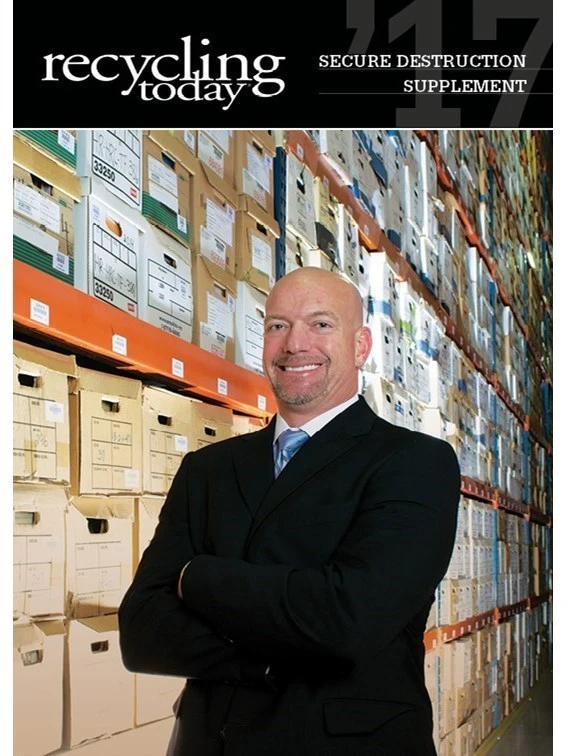
Whether secure destruction companies provide their services on-site or off-site, crucial objectives when servicing accounts are saving time and money and decreasing truck wear and tear. One of the ways these objectives can be achieved, sources say, is by optimizing routes using software designed for this purpose and the accompanying hardware, such as GPS-enabled and mobile devices. These tools can map out routes, provide live updates, allow easy access to employees and provide data on stops to make them more efficient.
Jim MacMillan, vice president of sales for Andrews Software Inc. (ASI), Cleveland, says the benefits of routing software can be apparent. While he says some of those benefits are “tangible,” such as decreased time on the road, which reduces wear and tear and fuel consumption, some benefits are less concrete. “You can improve corporate credibility with your customers. If you say you’ll be there at 10, you are more likely to hit that time a lot more often than if you’re free-wheeling it.”
Reaping the benefits
MacMillan says secure destruction companies could benefit most by using routing software that integrates with software for their overall business operations, “which drives the administrative part of the business that creates run sheets every day that
ASI, he offers as an example, integrates its business software with a third-party routing software. The company works with other companies that provide what MacMillan calls “fully fledged” routing systems to pull that information and put it on a mobile device so drivers and administrators can communicate routes more effectively.
“One thing our customers quite like is that there is a clock in the device, so you use that and track average stoppage times and how long the driver takes at each particular stop,” MacMillan says. This creates driver accountability—if a driver says he or she is at a stop for five minutes, administrators can check to see if that number is accurate through the software.
When shopping for software,
Ron Davey, president of Kitchener, Ontario-based RouteOptix, says mapping solutions, such as live maps and real-time traffic, that enhance optimization are beneficial. He also mentions the street view map available on most mobile devices.
“Streetside map view, which shows the building at street level, is particularly helpful for dispatchers to determine points of access into a building,” Davey says.
In terms of software features that are considered beneficial but nonessential, MacMillan says live route updates are “nice to have.”
He adds, “The office makes a phone call, and the driver has to stop and change [the route]. If you’re able to easily update that, it’s helpful.”
Other features MacMillan says he considers helpful are GPS tracking and real-time progress reports.
While MacMillan doesn’t consider progress reports a necessity, he says system reports produced after the route is completed
“We have a report, for example, that will visually identify areas where you have geographically gone to on two separate occasions,” MacMillan says. “So, if you know [two locations] are in the same area, and you
ASI’s routing component also can identify unattainable routes, he says. “[If] you build a route with 50 stops that
Whether companies service their clients on-site or off-site doesn’t make much difference when it comes to routing, he says, except for vehicle weight thresholds.
“If there’s an on-site service, those guys tend to be more interested in the weight capacity of the truck because, if they run out of anything, it’s the capacity to hold more material,” he says. “Off-site guys bring bins back to the plant, and they don’t get the weight threshold, but they’re more affected by space.”
Embracing the potential
Despite the benefits of routing software, Davey and MacMillan say most secure destruction companies have yet to incorporate it for a variety of reasons.
Davey says companies that are new to the industry might have financial reasons for not implementing software. “New companies typically start off using an accounting program for invoicing and either [Microsoft] Excel or a calendar type program for routing and scheduling,” he says. “While this is helpful
Davey continues, “It is very often an eye-opener that so much can be achieved to assist them in one application instead of multiple programs or manual processes when they do take that leap of faith.”
While routing software can be daunting to implement, MacMillan says the benefits should outweigh such concerns.
“There are a lot of variables—time, weight, space and customer time variables—that are all conflicting against each other,” he says. “It’s about building a realistic route and providing a human being with all the information so they can make an educated decision.”
Routing software can help to negotiate those variables, realizing new levels of efficiency.

Explore the October 2017 Secure Destruction Supplement Issue
Check out more from this issue and find your next story to read.
Latest from Recycling Today
- APR, RecyClass release partnership progress report
- Clearpoint Recycling, Enviroo sign PET supply contract
- Invista expanding ISCC Plus certification program
- Redwood partnership targets recycling of medium-format batteries
- Enfinite forms Hazardous & Specialty Waste Management Council
- Combined DRS, EPR legislation introduced in Rhode Island
- Eureka Recycling starts up newly upgraded MRF
- Reconomy Close the Gap campaign highlights need for circularity





